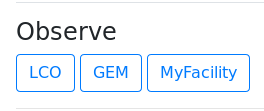Writing an observation module to interface with observatories¶
This guide will walk you through how to create a custom observation facility module using some mocked up endpoints to simulate a real observatory interface.
You can use this example as the foundation to build an observing facility module to connect to a real observatory.
Be sure you’ve followed the Getting Started guide before continuing onto this tutorial.
What is a observing facility module?¶
A TOM Toolkit observing facility module is a python module which contains the code necessary to provide an interface to an observing facility in a TOM. Some examples of existing modules are the Las Cumbres Observatory and the Gemini modules. Both allow the submission of observation requests to their respective observatories through a TOM.
Prerequisites¶
You should have a working TOM already. You can start where the Getting Started guide leaves off. You should also be familiar with the observing facility’s API that you would like to work with.
Defining the minimal implementation¶
Within any existing module in your TOM you should create a new python module
(file) named myfacility.py. For example, if you have a fresh TOM installation
you’ll have a directory structure that looks something like this:
├── data
├── db.sqlite3
├── manage.py
├── mytom
│ ├── __init__.py
│ ├── settings.py
│ ├── urls.py
│ └── wsgi.py
├── static
├── templates
└── tmp
We’ll place our myfacility.py file inside the mytom directory, next to
settings.py.
from tom_observations.facility import GenericObservationFacility, GenericObservationForm
class MyObservationFacilityForm(GenericObservationForm):
pass
class MyObservationFacility(GenericObservationFacility):
name = 'MyFacility'
form = MyObservationFacilityForm
We’ll go over what these lines mean soon. First, we’ll add a setting to our
project’s settings.py to tell the TOM Toolkit to use our new class:
TOM_FACILITY_CLASSES = [
'tom_observations.facilities.lco.LCOFacility',
'tom_observations.facilities.gemini.GEMFacility',
'mytom.myfacility.MyObservationFacility'
]
Now go ahead and view a target in your TOM, you should see something like this:
 myfacility
myfacility
This means our new observation facility module has been successfully loaded.
GenericObservationFacility and GenericObservationForm¶
You will have noticed our module consists of two classes that inherit from two other classes.
MyObservationFacility is the class that will contain the “business logic”
for interacting with the remote observatory. This includes methods to submit
observations, check observation status, etc. It inherits from
GenericObservationFacility, which contains some functionality that all
observation facility classes will want.
MyObservationFacilityForm is the class that will display a GUI form for our
users to create an observation. We can submit observations programatically, but it
is also nice to have a GUI for our users to use. The GenericObservationForm
class, just like the previous super class, contains logic and layout that all
observation facility form classes should contain.
Implementing observation submission¶
Now that we have the skeleton on an observation module set up, we should make it do something. Let’s assume our observatory only requires us to send 2 parameters (besides the target data): exposure_time and exposure_count. Let’s start by adding them to our form class:
from django import forms
from tom_observations.facility import GenericObservationFacility, GenericObservationForm
class MyObservationFacilityForm(GenericObservationForm):
exposure_time = forms.IntegerField()
exposure_count = forms.IntegerField()
Notice that we’ve added the two field definitions on our form. We’ve also imported
the django form module with from django import forms.
Now if we click on the “MyFacility” button on the observation facility list on the target page, we should see something like this:
 fields
fields
Now we’ll implement the method that performs an action with our form when we submit the observation request:
class MyObservationFacility(GenericObservationFacility):
name = 'MyFacility'
form = MyObservationFacilityForm
def submit_observation(self, observation_payload):
print(observation_payload)
return [1]
def validate_observation(self, observation_payload):
pass
def get_observation_url(self, observation_id):
return ''
def get_observation_status(self, observation_id):
return ['IN_PROGRESS']
def get_terminal_observing_states(self):
return ['IN_PROGRESS', 'COMPLETED']
def get_observing_sites(self):
return []
def data_products(self, observation_id, proudct_id=None):
return []
The important method here is submit_observation. This method, when implemented
fully, will send the observation payload to the remote observatory and then return
a list of observation ids. Those Ids will be stored in the database to be used
later: in methods like get_observation_status(self, observation_id). In our
dummy implementation, we simply print out the observation payload and return
single fake id with return [1].
If you now “submit” an observation using the MyFacility module, you should see this in the server console:
{'target_id': 1, 'params': '{"facility": "MyFacility", "target_id": 1, "exposure_time": 23, "exposure_count": 2}'}
That was our print statement!
Filling in the rest of the functionality¶
You’ll notice we added many more methods other than submit_observation to our
Facility class. For now they return dummy data, but when you adapt it to work with
a real observatory you should fill them in with the correct logic so that the
whole module works correctly with the TOM. You can view explanations of each
method in the source
code
Happy developing!
